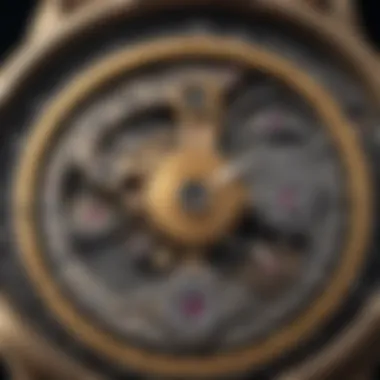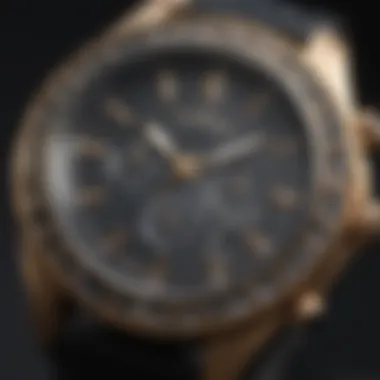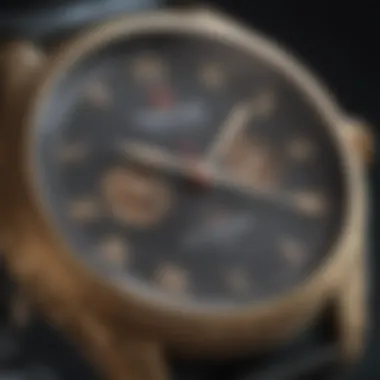Assessing the Value of Watches: Key Factors Explained


Intro
Determining the value of a watch requires a multifaceted approach. Various factors contribute to the market worth of timepieces, which can seem overwhelming. This guide serves as a compass in navigating the intricate landscape of watch valuation. We will dissect elements like brand prestige, materials, rarity, condition, and market trends. Each section will build on the last, creating a comprehensive understanding of watch valuation principles.
The world of watches is vast and diverse, encompassing styles that range from everyday wear to high-end luxury pieces. As consumers and collectors seek to bolster their knowledge, understanding these elements is vital. Through this guide, we will deliver insights that are not only useful but also crucial for anyone considering a watch purchase or sale.
By the end of this guide, readers will appreciate why certain watches command high prices, while others may not. We aim to equip enthusiasts and collectors with the tools needed to make informed decisions in the dynamic watch market.
Intro to Watch Valuation
Understanding the value of a watch is not only essential for collectors but also for anyone purchasing or selling timepieces. Watches represent a blend of art, technology, and craftsmanship. Analyzing their value involves multiple layers including brand reputation, materials used, and even the nuances of market demand.
The importance of watch valuation can be grouped into several key components. First, knowing the worth of a watch can significantly impact buying and selling decisions. When purchasing a luxury watch, for instance, it is crucial to discern whether a specific model appreciates in value over time or merely holds its price. This can be critical for collectors who intend to invest.
Second, understanding valuation can enhance appreciation for horology as a craft. The intricate details, the craftsmanship involved in making a watch, and the history behind each brand all add value beyond the monetary aspects.
Considerations in Watch Valuation
It is also essential to consider the fluctuations in market trends. Limited editions, market saturation, and economic conditions all impact watch values. Knowing how these elements play a role in valuation can provide a more comprehensive understanding of the opportunity for investment.
Beyond financial aspects, assessing the value of watches contributes to the overall enjoyment and satisfaction of owning them. For enthusiasts and collectors, each timepiece tells a story, and understanding its value helps to enrich that narrative.
Understanding Watch Brands
In the realm of horology, the brand of a watch profoundly affects its perceived value and desirability. A brand embodies not just the quality and craftsmanship of its products but also the heritage and narrative behind each timepiece. High-status brands often command higher prices due to their reputation, while more accessible brands cater to a broader market. Understanding the distinctions between these categories is essential for anyone looking to comprehend the dynamics of watch valuation.
Luxury Brands vs. Mass Market
Luxury watch brands represent the zenith of craftsmanship, innovation, and reputation. Examples include Rolex, Patek Philippe, and Audemars Piguet. These brands often employ exclusive materials, complex movements, and hand-finished details. The price points can be astronomical due to their limited supply, durability, and craftsmanship. Their watches are seen not merely as timekeeping devices but as status symbols.
- Exclusivity: Limited production runs and high-quality guarantees contribute to their allure.
- Craftsmanship: Typically involve intricate movement design, often requiring skilled artisans to produce.
- Investment Value: Maintaining or increasing value over time makes them appealing to collectors.
In contrast, mass-market brands like Seiko or Citizen offer reliable timepieces tailored for everyday wear. These watches are often produced in large quantities and offer functionalities at a competitive price.
- Affordability: Price points are accessible, making them appealing to a broader audience.
- Versatility: Generally designed for daily wear, with a focus on durability and function.
- Widely Available: Readers looking to start their collection may find these brands as practical entry points.
Understanding the landscape of luxury versus mass-market brands helps potential buyers make informed decisions based on their needs and investment goals.
Iconic Brands and Their Legacy
Certain brands have transcended mere product offerings to become cultural icons. These are not just companies; they represent rich histories, technological advancements, and societal impacts. Brands like Omega, TAG Heuer, and IWC Schaffhausen have set benchmarks for luxury and innovation in horology.
- Historical Significance: Many iconic brands have been around for over a century, expanding their legacy through innovation and landmark achievements, like Omega's association with space travel.
- Cultural Impact: Timepieces from brands like Rolex have permeated popular culture, sparking desire and admiration beyond their functional purpose.
- Quality as a Standard: Most of these brands maintain strict quality controls and uphold superb craftsmanship, positioning themselves as leaders in the watchmaking industry.
An appreciation for the artistry and history behind these iconic brands enhances understanding of their value in the current market. Collectors and enthusiasts should consider both market trends and the rich legacies underpinning these names when assessing any potential purchase.
Factors Influencing a Watch's Value
Understanding the various factors that influence a watch's value is crucial for collectors and enthusiasts alike. These elements provide context on why certain pieces command higher prices in the market while others may not perform as well. From the materials used in construction to the complexity of craftsmanship, each factor contributes to a watch's overall worth.
Materials Used in Construction
Precious Metals
Precious metals play a significant role in the valuation of watches. Gold, platinum, and silver are not only attractive but contribute to the intrinsic value of the timepiece. For example, gold watches are often seen as status symbols. Their durability is another aspect that adds to their appeal.
The unique feature of precious metals is their resistance to tarnish and corrosion. This quality ensures longevity, making them a desirable option for collectors. However, the high cost of materials can deter potential buyers.
Gemstones


Gemstones are a key characteristic in luxury watches and can significantly elevate their value. Diamonds, sapphires, and rubies serve both decorative and functional purposes. Their sparkle and rarity can create a dramatic effect, reflecting personal taste and sophistication.
Incorporating gemstones also increases the watch's craft value, but it can add to maintenance concerns. Scratched or damaged stones can detract from a watch's beauty and value.
Synthetic vs. Natural Materials
The choice between synthetic and natural materials can influence a watch's market appeal. Natural materials might offer authenticity and uniqueness, while synthetic options often provide durability and lower costs. Synthetic materials can mimic the appearance of natural stones or metals without the price tag.
A unique feature is the environmental consideration; synthetic materials often have a lower ecological impact. This might make them a more popular choice among environmentally conscious buyers, but some collectors still favor natural options for their perceived value.
Craftsmanship and Movement
Automatics vs. Quartz
The movement of a watch is a pivotal factor in its valuation. Automatic movements are often favored for their craftsmanship and mechanical complexity. They require a certain level of expertise to manufacture, which can drive prices higher.
Quartz watches, on the other hand, are known for their accuracy and lower production cost. The ease of manufacturing quartz movements makes them accessible, but they may lack the prestige that comes with automatics. Many collectors appreciate the intricate mechanical movements, which often carry a higher premium.
Swiss Made Significance
The term "Swiss Made" is synonymous with quality. It indicates a high standard of excellence in watch-making that many collectors trust. Swiss craftsmanship is generally more rigorous, contributing to the overall prestige of the timepiece.
Additionally, being Swiss made can improve resale value, as buyers often consider this tag a mark of quality. However, this comes at a cost, with many Swiss watches priced at a premium compared to others.
Condition and Authenticity
Servicing and Maintenance
Regular servicing and maintenance are vital in ensuring a watch maintains its value. Watches that are well-maintained often fetch higher prices on the resale market. Buyers look for signs of proper care when evaluating potential purchases.
A unique feature is that serviced watches tend to operate at optimal performance levels, connecting to both functionality and prestige. However, the cost of servicing can add up, which potential buyers must consider.
Original Parts vs. Replacements
The presence of original parts can significantly affect a watch's worth. Watches equipped with original components are more desirable than those with replaced parts. Replacement components can raise concerns about authenticity, which in turn, diminishes value.
A key aspect here is that original parts provide a sense of history and provenance. Collectors often look for this when making investment decisions. However, finding original parts might be challenging, especially for vintage models.
Market Dynamics and Trends
Market dynamics significantly shape the value of watches. Understanding trends is essential for collectors, enthusiasts, and investors. The watch market, like any other, is influenced by various factors that fluctuate according to consumer demand, economic conditions, and social shifts. Therefore, being aware of these dynamics offers insights into potential valuation in the present and future.
Historical Sales Data
Price Evolution Over Time
Price evolution over time tracks how watch values change through years. This aspect provides a historical context that can be invaluable for assessing the worth of specific timepieces. The key characteristic of this metric is its ability to reveal patterns, showing how certain brands or models appreciate or depreciate. By examining previous trends, it helps collectors make informed decisions about buying and selling.
Such data is a beneficial choice for this article. It adds depth to discussions on valuation and reflects the overall health of the watch market.
One unique feature of price evolution is the ability to predict potential future value drift. However, the inherent unpredictability of the market can also pose disadvantages. Not every watch follows a predictable path, and external events may lead to sudden shifts.
Benchmark Auctions and Their Impact
Benchmark auctions serve as significant indicators of market value. The performance of watches in esteemed auction houses offers real-time insights into current valuations and trends. The key characteristic of these auctions is their ability to set benchmarks for pricing, becoming reference points for future sales.
These benchmarks greatly benefit this article by providing concrete examples of how different watches fare in competitive settings. They reflect not just prices but also buyer enthusiasm and market trends.
A unique feature of benchmark auctions is the transparency they bring to the market. They publicly showcase what buyers are willing to pay, which can be advantageous for gauging demand. On the downside, auction results can sometimes be misleading due to the influence of a few high-profile sales that do not reflect the broader market.


Influence of Social Media
In recent years, social media has transformed how watches are bought and sold. It has created a new platform for discussions about trends, preferences, and pricing. The importance of this element lies in its capacity to reach a wide audience, thereby affecting the market on a large scale.
User-Generated Content
User-generated content has emerged as a powerful force in shaping public perception and market trends. This aspect encourages discussion around watch brands, models, and styles. The key characteristic here is authenticity; content created by everyday users carries a weight that traditional advertising often lacks.
This content is popular for this article because it represents the voice of the consumer. It facilitates a deeper connection between watch enthusiasts and the products they love.
The unique feature of user-generated content is its diverse range of perspectives. However, it may dilute authoritative voices, creating confusion for those seeking expert input. Therefore, while it can influence opinions, it may also cloud judgment.
Influencer Impacts on Market Prices
Influencer impacts on market prices illustrate how personalities in the digital realm can drive demand. Influencers can highlight specific watches, sometimes leading to drastic price changes. The key characteristic here is their ability to reach specific niche audiences, often sparking interest in certain brands or models.
Understanding influencer dynamics is a beneficial addition to this article, as it reveals how modern marketing strategies can shift traditional valuation frameworks.
A distinct feature of this influence is its speed; trends can arise overnight due to popular endorsements. However, this can introduce volatility as well. Price spikes might not be sustainable long-term, leading potential investors to proceed with caution.
Rarity and Exclusivity
Rarity and exclusivity are fundamental concepts in the evaluation of watches. These attributes influence not only the desirability of specific timepieces but also their market value. A watch's rarity can drastically affect its worth; limited production runs, unique features, or special collaborations often result in higher prices. Collectors and enthusiasts actively seek these timepieces, as they represent not just a functional accessory but also a piece of art and history.
Understanding Rarity
Rarity comes from various factors, primarily production volume and uniqueness. Limited editions are manufactured in small quantities, creating an inherent scarcity. Each limited watch is often tied to a specific event or milestone in a brand’s history. For collectors, owning a rare watch can signify a connection to that history while also representing a solid investment.
Benefits of Exclusive Watches
Owning an exclusive watch enhances personal status. These pieces often come with additional prestige. When collectors wear or display such watches, they signal a deeper appreciation of horological craftsmanship. Moreover, exclusive watches frequently appreciate in value more than regular production models. This means that collectors are not just buying a timepiece but also an asset that may grow in worth over time.
Quote:
"In the realm of luxury watches, it is not only the brand but also the rarity that often leads to soaring prices."
Considerations in Valuation
When assessing watches for their rarity, it is vital to consider condition and provenance. A beautifully maintained limited edition will generally command a higher value. Additionally, documentation that confirms authenticity can make a significant difference. A lack of original box or papers may lead to depreciation.
In summary, rarity and exclusivity are not merely marketing strategies; they are essential aspects of the valuation process. Understanding these factors enables enthusiasts to make informed decisions while navigating the intricate world of watch collecting.
Limited Editions
Limited editions hold immense significance in the watch community. These timepieces often celebrate milestones or commemorate historical events. The restricted number produced adds to their allure. Buyers generally have a sense of urgency upon a new release, knowing that the opportunity may not come again.
Attributes of Limited Edition Watches
- Production Numbers: Typically, these models are produced in small batches, sometimes as few as 50 or 100.
- Special Features: Many limited editions include unique dial designs or materials not found in standard models.
- Collector Interest: Limited release watches often become the centerpiece of a collection due to their potential for value appreciation.
Investment Value
Investing in limited editions can be a savvy move. For example, the Omega Speedmaster, released in limited quantities to honor a space mission, has seen its value rise substantially over the years. Collectors often look for such pieces, remaining aware of how market demand can shift interest and prices.
Discontinued Models
Discontinued models can also be valuable due to their absence from the market. When a brand stops producing a specific watch, it can create a scarcity that heightens interest among collectors.
The Appeal of Discontinued Models
- Historical Significance: These watches may represent an era or technology that is no longer available.
- Defined Editions: Often, models are discontinued because they were experimental or had a limited run, adding to their intrigue.
- Value Retention: They can appreciate significantly over time, particularly if well-maintained.
Collector Considerations
Before purchasing a discontinued model, it's important to verify its condition and authenticity. Restoration can sometimes affect lasting value, so buyers must be cautious. Moreover, understanding the historical context surrounding the model can provide insights into its long-term value.
Dealer Insights and Marketplace


In the realm of watch valuation, understanding the nuances of the marketplace and the role of dealers is vital. The relationship between the buyer and the dealer can significantly influence the worth and appreciation of timepieces. This section explores the complexities of the dealer network, emphasizing the distinctions between authorized dealers and gray markets, along with the dynamics of online marketplaces and auctions. Each element plays a crucial role in how watches are priced and sold in today’s market.
Authorized Dealers vs. Gray Market
The distinction between authorized dealers and gray market sellers is essential for any watch collector or enthusiast. Authorized dealers operate with direct connections to watch brands, which ensures that they sell authentic pieces with full warranties. Buyers can trust that they receive genuine products with valid documentation. This trust translates into a higher perceived value for watches bought through authorized channels.
On the other hand, gray market dealers often provide similar watches at lower prices, but without authorization from brands. These channels can be tempting; however, they carry risks, including limited or no warranty coverage and the possibility of purchasing counterfeit or non-genuine items. Ultimately, collectors must weigh the potential savings against the assurance of quality and authenticity that authorized dealers provide. Variations in pricing based on these factors can also be substantial.
Online Marketplaces and Auctions
The rise of online marketplaces has transformed how watches are bought and sold. These platforms offer a vast selection of timepieces, often at competitive prices. However, the accessibility of these marketplaces also presents challenges that buyers must navigate.
Risks and Advantages
The significant advantage of online marketplaces is the breadth of options available to consumers. Platforms like Chrono24 or eBay make it easy to find both new and vintage pieces from various sellers worldwide. However, risks accompany this convenience. Fraudulent listings and counterfeit products are more prevalent in unregulated spaces. Buyers must exercise caution and diligence, verifying sellers and inspecting listings closely.
The key characteristic of online platforms is their ability to connect buyers and sellers globally, potentially leading to good deals. Nevertheless, these platforms can lack the support systems that authorized dealerships offer, such as expertise in servicing and authenticity guarantees. Hence, they may be a popular choice for those looking for rare finds but can be a gamble in value and quality.
Verification Processes
Verification processes are critical in ensuring that transactions in online marketplaces uphold the expected standards of authenticity and quality. Many platforms have begun to implement better verification systems, including professional inspections and buyer protection plans. These steps help mitigate the risks associated with purchasing high-value watches online.
The key feature of verification processes is that they provide buyers with a layer of security in a crowded marketplace. As a result, they are increasingly popular in the world of watch trading. Plus, robust verification can enhance buyer confidence, leading to more robust market activity. Nonetheless, despite these advancements, buyers should remain vigilant.
Overall, the dealer insights and marketplace dynamics are fundamental to understanding how watches are valued. Knowing the differences between authorized and gray market sellers, as well as the risks and verification involved in online transactions, can empower buyers to make informed decisions, ultimately influencing the value of their timepieces.
The Role of Certification
Understanding the role of certification is vital when assessing the value of watches. Certification helps in establishing authenticity, which is a cornerstone of trust in the watch market. This is particularly true for collectors and enthusiasts who often invest considerable sums in timepieces. In a market where counterfeiting is prevalent, having a certified watch can be the difference between an intelligent purchase and a costly mistake.
Beyond authenticity, certification offers assurance regarding the quality of craftsmanship and materials. For buyers, it elevates the confidence in their purchase, knowing it meets certain standards set by recognized bodies. This, in turn, can have a significant impact on resale value and marketability in the future.
Importance of Watch Certification
Watch certification serves multiple purposes. First, it guarantees that the watch is genuine and not a replica. A certified watch typically includes documentation verifying its authenticity, which can greatly enhance its resale potential. Buyers appreciate this documentation because it simplifies the process of determining the watch’s history and authenticity, addressing doubts that might otherwise deter them from a purchase.
Second, certification can indicate adherence to specific quality parameters. For example, Swiss watches often seek certification to confirm their Swiss Made status, which is a mark of prestige in the industry. Thus, the emphasis on certified pieces reflects a deeper understanding of craftsmanship among high-value timepieces.
Lastly, engaging with certified watches helps foster a more credible watch market. As more people become aware of the importance of certification, there is a collective movement towards valuing more authentic pieces over replicas. This shift is essential for maintaining value over time and supporting watchmakers in their commitment to quality.
Recognized Certification Bodies
Several bodies are recognized internationally when it comes to watch certification. Notable among these are the Swiss Official Chronometer Testing Institute (COSC) and the International Watch and Clock Foundation (IWCF). COSC is famous for certifying the precision of Swiss watches, which can significantly increase their market value. Sympathetically, the IWCF focuses on preserving the history and education of horology, although not providing direct certification.
Each of these organizations has its criteria and standards, which influence how watches are assessed. For example, a watch that has undergone COSC certification will be labeled as a Chronometer, signifying its exceptional accuracy. Buyers often pay a premium for watches with such credentials.
To summarize, certification is not merely an optional extra; it is a necessary facet that influences the valuation and trustworthiness of watches in the market. Understanding this aspect can significantly aid collectors and enthusiasts in making informed decisions.
"A certified watch stands as a testament to quality, precision, and authenticity in an ever-evolving marketplace."
For more information on certification standards, visit Wikipedia and other watch-focused communities on Reddit.
The End: Making Informed Decisions in Valuation
In the realm of watch valuation, making informed decisions is crucial for both collectors and enthusiasts. The importance lies not just in acquiring a timepiece but understanding its intrinsic value. Numerous factors influence a watch’s worth, such as brand reputation, rarity, craftsmanship, and condition. Each of these elements plays a significant role in determining not only the market price but also the emotional and aesthetic value of the piece.
Consumers must consider the history of the brand and its influence within the market. Brands with a deep-rooted heritage, like Rolex or Patek Philippe, often command higher prices due to their storied pasts and the prestige associated with them. It’s essential to recognize that this heritage isn't just about nostalgia; it's about understanding what drives demand for these pieces.
Furthermore, rarity significantly affects valuation. Limited edition watches or those from discontinued lines tend to be more sought after. This scarcity creates a unique blend of desirability and competition among collectors, thus driving the price higher. Therefore, being aware of what makes a watch rare can yield significant insights for potential buyers and sellers.
Condition is another pivotal aspect that cannot be overlooked. A well-preserved watch retains its value much better than one that shows wear and tear. Certified servicing history, original parts, and careful maintenance are factors potential buyers should investigate thoroughly. Documentation of authenticity also adds an extra layer of value.
"A watch is not just a tool; it is a narrative that unfolds over time, revealing the expertise involved in its creation as well as the stories surrounding its use."
Moreover, market dynamics influence these valuations. Understanding trends and shifts in collector interest can provide insights into prospective investments. Following auction results and market reports can highlight what collectors currently desire, which can aid in making informed purchases or sales.







